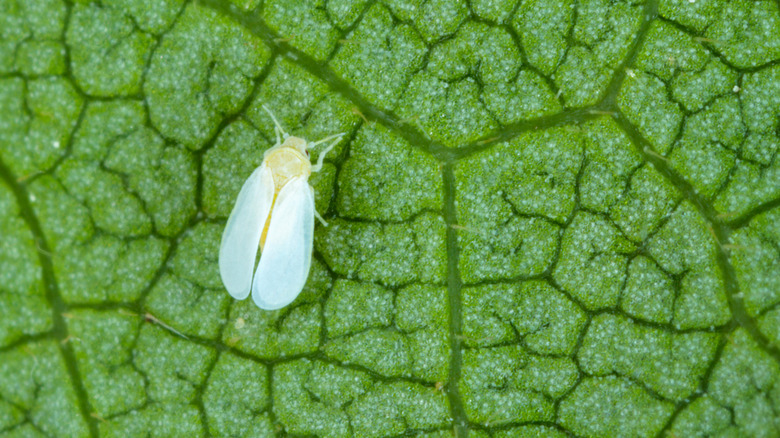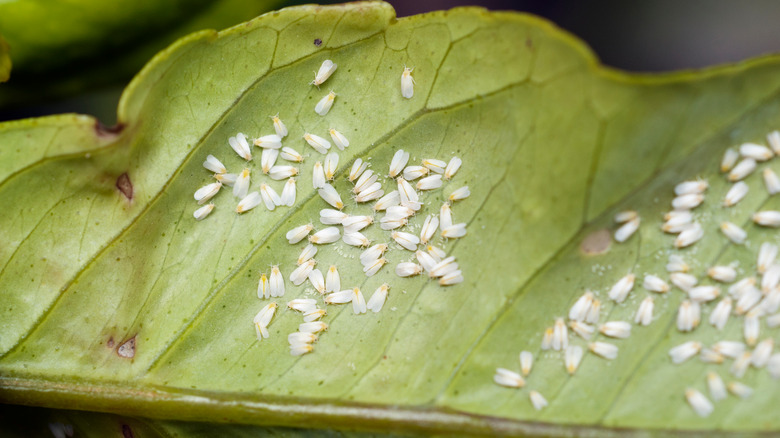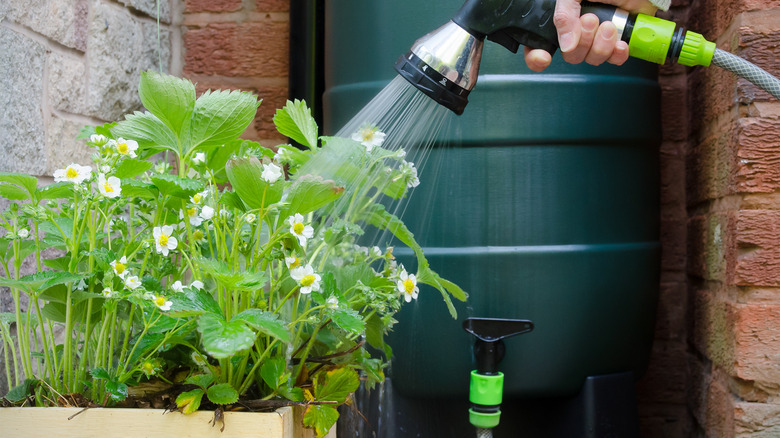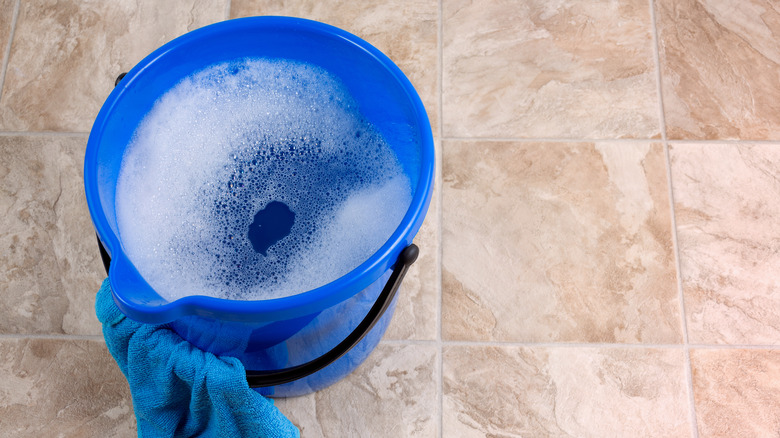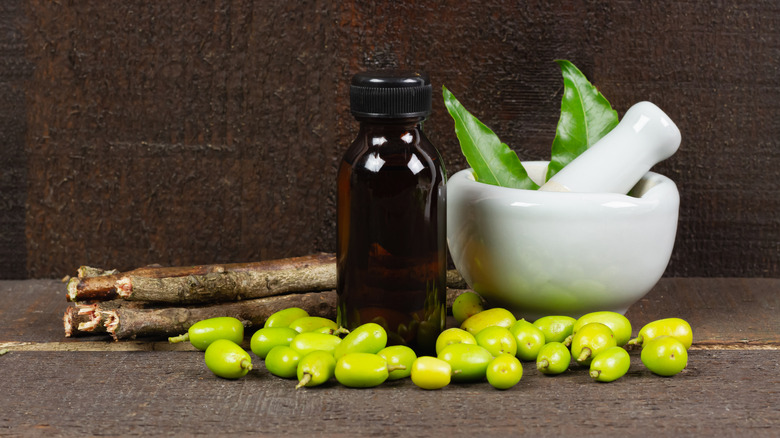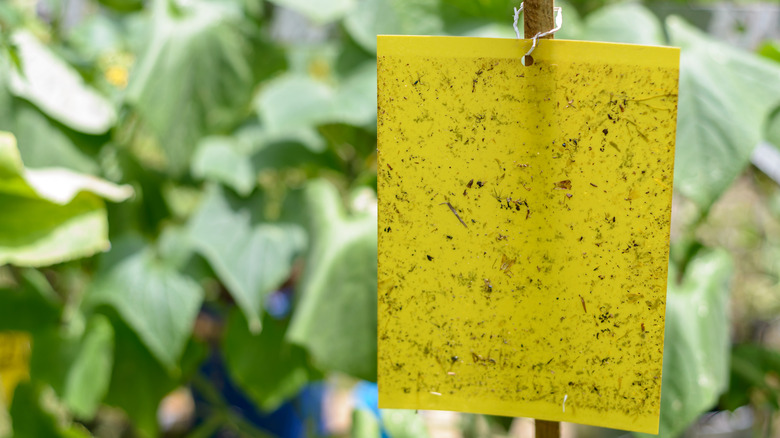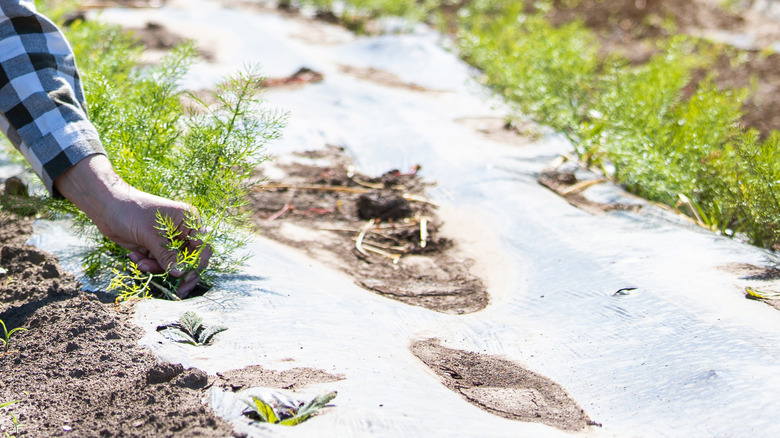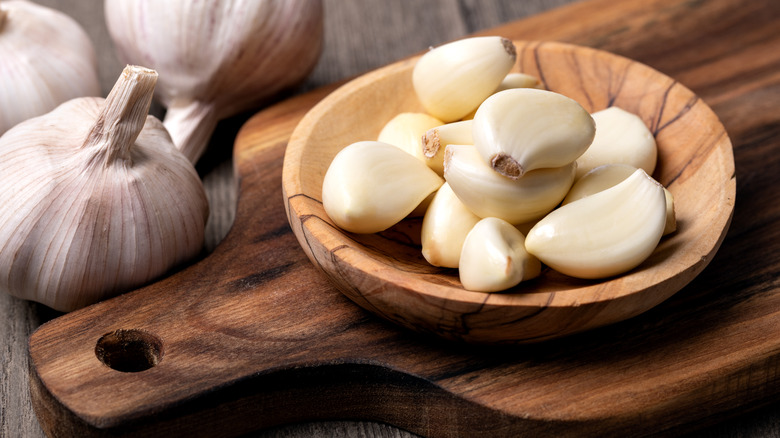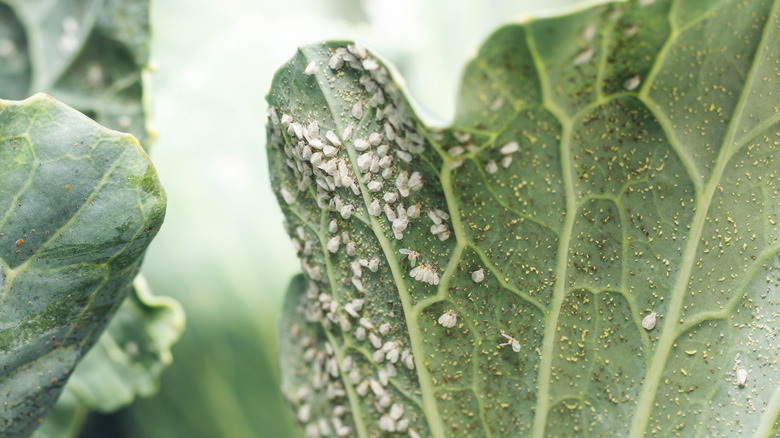8 Best Ways To Get Rid Of Whiteflies
Tiny winged insects known as whiteflies make quick work of infesting your garden. An adult whitefly (which isn't an actual fly at all) can lay up to 400 eggs, Epic Gardening writes, which are attached on the backside of leaves. Similar to their close cousins, aphids, whiteflies act as miniscule vampires once they hatch, sucking out vital plant juices from their leaves and spreading disease.
If you notice your plants struggling, especially during warmer months, do a quick check for whiteflies. They inhabit both indoor and outdoor plants, but need warm conditions to survive. Tiny insects with a double-set of wings may appear when you disturb plant leaves — the first sign you have a whitefly problem. Flip to the leaf underside and look for mini white ovals, whitefly eggs, and a sticky substance referred to as honeydew. The Old Farmer's Almanac notes that they're especially attracted to new growth, so be sure to examine newer unfurled leaves, especially around the veins.
Though they're a true pest once they've established themselves in your garden or on houseplants, you can conquer whiteflies with a little persistence. Here are some ways to get rid of whiteflies for good.
1. Vacuum them up
To rid your plants of whiteflies, you must first remove them from the picture completely. This means getting them off your leaves for good — if you simply shake them away, they'll eventually fly back to your plants and get right back to destroying them. Bob Vila recommends taking a handheld vacuum and sucking up the insects and larvae. It's an effective way to clean up the leaves while also trapping the whiteflies.
If your plant is delicate, be careful not to suck off the leaves entirely with the vacuum (or try a different method to remove them). Once you've cleaned the leaves of whiteflies and larvae, pluck off any leaves that are seriously damaged or that are covered in the sticky honeydew.
Bob Vila also warns that you should be careful when you empty the vacuum — rather than dump it directly into the trash, seal everything in a plastic bag.
2. Hose them off
If you have a particularly large infestation of whiteflies, taking the time to vacuum every leaf in your garden might not be in the cards. Luckily, there's a simple tool that Epic Gardening says can expedite the process: your garden hose.
Spray your plants at the harshest pressure they can manage, taking extra care on the plants that are damaged or have leaves teaming with the bugs. This will knock off the nymphs while they are still in their delicate "crawler" stage and cannot survive off the leaf (or withstand the cold water). After, clip off any leaves that are beyond repair or are covered in the sticky honeydew fluid.
Once you've blasted your plants with the hose, you'll need to quickly follow up with one of the solutions listed below that detracts the adult insects, which can fly back to their favorite plants and start the whole process again.
3. Mix a dish soap solution
Once you've removed whiteflies and their eggs or nymphs from your plant, it's time to keep them from returning. One simple solution is to apply an insecticidal soap. Commercial options are available, but The Old Farmer's Almanac writes that you can easily concoct your own with a squirt of dish soap mixed in a gallon of water. Per The Spruce, don't use a clear dish detergent because they are not the same as soaps, and avoid scents. Brands like Ivory Liquid, Ivory Snow, Dr. Bronner's, and Shaklee's Basic H should do the trick.
Add to a spray bottle and squirt it onto your plant's leaves when temperatures are coolest, like evening time, to avoid the sun reacting with the solution (or bothering pollinators buzzing around). As this is a mild solution that will only kill adult whiteflies, you may need to follow up two to three times.
4. Neem oil
Horticultural oils are another way to make your plants less attractive to those pesky whiteflies. Bob Vila recommends neem oil, an extract from neem tree seeds that won't harm your garden. There are a few ways to use neem oil. Concentrated neem oil is mixed with water and then sprayed on plants per the package's instructions — apply to both the top and underside of leaves until they are very wet. There's also neem tree granules that are mixed into the soil and neem dust that you apply to your plant's leaves and stems.
Spray in the early evening or morning to avoid harming pollinators (the oil won't affect them once it's dried and no longer airborne). Wilson Bros Gardening recommends reapplying neem oil again after 72 hours. Once applied, neem will interrupt all stages of whiteflies, from adult to egg. Another commercial horticultural repellent, Bonide All-Seasons Horticultural and Dormant Spray Oil, has a similar affect, according to Epic Gardening.
5. Set whitefly traps
Another method to control whitefly populations once they've already infiltrated your garden is to trap them. Dian Farmer writes that whiteflies are attracted to the color yellow, so setting sticky traps (that come in yellow) will lure them in (Plus, you'll also draw out pests like aphids, thrips, and fruit flies.) You can also make your own DIY traps if you don't want to spend money on the commercial options. Apply a sticky coating onto durable yellow cards, like mineral oil or petroleum jelly, and the tiny flies will stick to the paper.
Wilson Bros Gardening recommends hanging the traps at the top of plants teeming with whiteflies. Indoors, place them in doorways, screens, vents, and other places the whiteflies are coming in. Though whitefly traps will not stop the infestation, they let you know when whiteflies are active while also taking some adults out of the game.
6. Try reflective mulch
Reflective mulch is another organic way to discourage whiteflies from setting up shop on your plants. The Old Farmer's Almanac says that reflective mulch confuses whiteflies, and the light it shines makes it hard for them to find their favorite plants. You can purchase reflective mulch (e.g. silver polyethylene mulch, which comes in rolls) or whip up a homemade hack by affixing reflective aluminum foil to cardboard. Another DIY tip from Gardening Know How is to spray paint landscape fabric — or plastic mulch — silver.
To add organic gardening mulch to your garden, clear away weeds and then begin rolling the mulch out (if you already have grown plants, this will require some maneuvering). Cut holes directly along the mulch row for new seedlings you wish to plant. When you're done, stake or cover the mulch roll with dirt along the sides to keep it in place. Mulch early in the season, and SF Gate recommends removing it during the hottest summer months, when the reflective light can start to overheat plants.
7. Garlic spray
Like most bugs and pests, whiteflies are repelled by garlic, so a homemade garlic spray can work wonders against them. But it will work better as an outdoor solution since the scent will dominate indoor spaces (including greenhouses).
You'll first need four cloves of garlic and mineral oil to kick off this DIY concoction from Birds and Blooms. To start, mince the cloves and then let them sit in 1 tablespoon of mineral oil for one day. Strain out the garlic from the oil and then mix the oil into a pint of water along with 1 teaspoon of dish soap.
Pour into a spray bottle and mix it up before spraying. You should test out a small section of the plant before going to town, in case it doesn't like the mixture. If the test leaf yellows or experiences other damage after a day, further dilute the mixture.
8. Introduce natural predators
One further thing that will control whiteflies in your garden is the fear of becoming something's dinner. To that end, natural insect predators to whiteflies include ladybugs, damselflies, dragonflies, spiders, and green lacewings, according to The Old Farmers Almanac. And Dian Farmer says female beetles, tiny parasitic wasps, and Encarsia Formosa wasps feed on adult whiteflies as well as their eggs. You can attract beneficial insects in a few ways, per Learning With Experts, including providing a variety of pollen and nectar sources, maintaining some native plants, and avoiding chemical pesticides.
Hummingbirds (as well as a few other species) will also snack on some whiteflies for their meals. Make your garden cozy for them with red feeders filled with nectar and a water source, Hummingbird Guide writes. Creating a dragonfly habitat will also keep whiteflies in check, with the added benefit of reducing pesky mosquitos as well.
